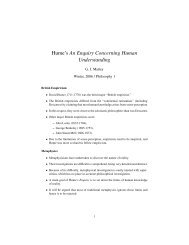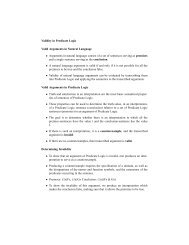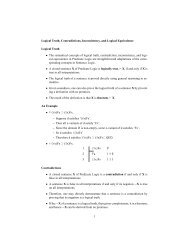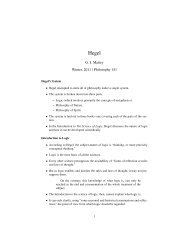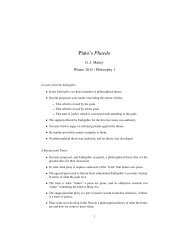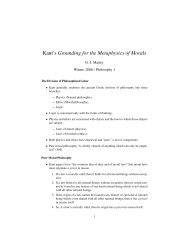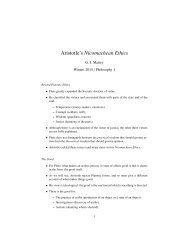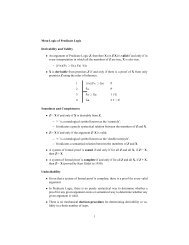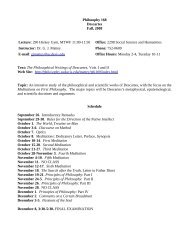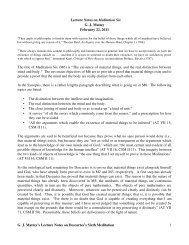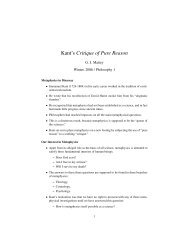Basic Syntax and Semantics of Modal Logic
Basic Syntax and Semantics of Modal Logic
Basic Syntax and Semantics of Modal Logic
Create successful ePaper yourself
Turn your PDF publications into a flip-book with our unique Google optimized e-Paper software.
Module 3<br />
<strong>Basic</strong> <strong>Syntax</strong> <strong>and</strong> <strong>Semantics</strong> for <strong>Modal</strong> Sentential <strong>Logic</strong><br />
G. J. Mattey<br />
December 7, 2009<br />
Contents<br />
1 <strong>Syntax</strong> <strong>of</strong> <strong>Modal</strong> Sentential <strong>Logic</strong> 2<br />
1.1 Expressions <strong>of</strong> MSL . . . . . . . . . . . . . . . . . . . . . . . . . . . . . . . . . . . . . . . 2<br />
1.2 Rules <strong>of</strong> Formation for MSL . . . . . . . . . . . . . . . . . . . . . . . . . . . . . . . . . . 2<br />
2 Informal Interpretations <strong>of</strong> MSL Operators 3<br />
2.1 ‘□’ as a Necessity Operator . . . . . . . . . . . . . . . . . . . . . . . . . . . . . . . . . . . 3<br />
2.2 ‘♦’ as a Possibility Operator . . . . . . . . . . . . . . . . . . . . . . . . . . . . . . . . . . 3<br />
2.3 ‘’ as a Strict Implication Operator . . . . . . . . . . . . . . . . . . . . . . . . . . . . . . 4<br />
3 Inter-Definition <strong>of</strong> <strong>Modal</strong> Operators 4<br />
3.1 Reduction to One Primitive <strong>Modal</strong> Operator . . . . . . . . . . . . . . . . . . . . . . . . . . 4<br />
3.2 Other <strong>Modal</strong> Operators . . . . . . . . . . . . . . . . . . . . . . . . . . . . . . . . . . . . . 5<br />
3.2.1 Intensional Disjunction . . . . . . . . . . . . . . . . . . . . . . . . . . . . . . . . . 5<br />
3.2.2 Impossibility . . . . . . . . . . . . . . . . . . . . . . . . . . . . . . . . . . . . . . 5<br />
3.2.3 Consistency . . . . . . . . . . . . . . . . . . . . . . . . . . . . . . . . . . . . . . . 6<br />
3.2.4 Strict Equivalence . . . . . . . . . . . . . . . . . . . . . . . . . . . . . . . . . . . 6<br />
4 <strong>Basic</strong> <strong>Semantics</strong> for MSL 6<br />
4.1 Truth-Value Assignments . . . . . . . . . . . . . . . . . . . . . . . . . . . . . . . . . . . . 7<br />
4.2 Formal <strong>Semantics</strong> for MSL . . . . . . . . . . . . . . . . . . . . . . . . . . . . . . . . . . . 9<br />
4.2.1 Generalized Valuation-Functions . . . . . . . . . . . . . . . . . . . . . . . . . . . . 9<br />
4.2.2 The Accessibility Relation . . . . . . . . . . . . . . . . . . . . . . . . . . . . . . . 9<br />
4.2.3 Semantical Rules . . . . . . . . . . . . . . . . . . . . . . . . . . . . . . . . . . . . 11<br />
4.3 Meta-<strong>Logic</strong>al Properties <strong>and</strong> Relations in MSL . . . . . . . . . . . . . . . . . . . . . . . . . 13<br />
4.3.1 Semantical Entailment in a Frame . . . . . . . . . . . . . . . . . . . . . . . . . . . 13<br />
4.3.2 Semantical Equivalence in a Frame . . . . . . . . . . . . . . . . . . . . . . . . . . 14<br />
4.3.3 Validity in a Frame . . . . . . . . . . . . . . . . . . . . . . . . . . . . . . . . . . . 15<br />
5 Conclusion 16<br />
1
In this module, we will begin our examination <strong>of</strong> <strong>Modal</strong> Sentential <strong>Logic</strong>, or MSL. <strong>Modal</strong> Sentential<br />
<strong>Logic</strong> is an extension <strong>of</strong> non-modal Sentential <strong>Logic</strong>. All the sentences <strong>of</strong> SL are sentences <strong>of</strong> MSL, <strong>and</strong><br />
some sentences <strong>of</strong> MSL are not sentences <strong>of</strong> SL. The first section <strong>of</strong> the module will describe the syntax<br />
<strong>of</strong> MSL. The set <strong>of</strong> expressions <strong>of</strong> SL will be exp<strong>and</strong>ed by the addition <strong>of</strong> modal operators, <strong>and</strong> the set <strong>of</strong><br />
sentences composed <strong>of</strong> those expressions will be exp<strong>and</strong>ed by the addition <strong>of</strong> sentences containing modal<br />
operators. The brief second section shows how each <strong>of</strong> the modal operators can be defined in terms <strong>of</strong> the<br />
others. The third <strong>and</strong> final section sets out the basic elements <strong>of</strong> semantics <strong>of</strong> MSL. In later modules, the<br />
basic semantics will be refined in order to produce various semantical systems <strong>of</strong> modal logic.<br />
1 <strong>Syntax</strong> <strong>of</strong> <strong>Modal</strong> Sentential <strong>Logic</strong><br />
Historically, a number <strong>of</strong> different modal sentential languages have been constructed by taking different<br />
modal operators as primitive. 1 Most versions <strong>of</strong> modal logic syntax add to the expressions <strong>of</strong> SL two oneplace<br />
operators: the box ‘□’ <strong>and</strong> the diamond ‘♦.’ 2 We will treat these operators as primitive <strong>and</strong> add to the<br />
set <strong>of</strong> primitive operators the two-place “strict implication” operator, ‘.’ A sentence whose main logical<br />
operator is a modal operator will be called a modal sentence. 3<br />
1.1 Expressions <strong>of</strong> MSL<br />
We extend the expressions <strong>of</strong> SL to obtain the vocabulary <strong>of</strong> MSL.<br />
• An infinitely large set <strong>of</strong> sentence letters A, B, C, . . . , Z, A 1 , B 1 , . . . , Z 1 , A 2 , B 2 , . . ..<br />
• A sentential constant ‘⊥.’<br />
• Two punctuation marks ‘(’ <strong>and</strong> ‘).’<br />
• A set <strong>of</strong> five truth-functional operators, ‘∼,’ ‘∧,’ ‘∨,’ ‘⊃,’ <strong>and</strong> ‘≡.’<br />
• A set <strong>of</strong> three modal operators, ‘□,’ ‘♦,’ ‘.’<br />
Every expression <strong>of</strong> SL is an expression <strong>of</strong> MSL, but not every expression <strong>of</strong> MSL is an expression <strong>of</strong> SL.<br />
1.2 Rules <strong>of</strong> Formation for MSL<br />
Corresponding to the three new modal operators are three new rules <strong>of</strong> formation, rules 8 through 10.<br />
1. All sentence letters are sentences <strong>of</strong> MSL.<br />
2. ‘⊥’ is a sentence <strong>of</strong> MSL.<br />
3. If α is a sentence <strong>of</strong> MSL, then ∼α is a sentence <strong>of</strong> MSL.<br />
4. If α <strong>and</strong> β are sentences <strong>of</strong> MSL, then (α ∧ β) is a sentence <strong>of</strong> MSL.<br />
1 An operator is primitive when it is specified in the original list <strong>of</strong> expressions <strong>of</strong> the vocabulary to which it belongs. An operator<br />
is defined when it does not appear in the original list, but is instead specified through the use <strong>of</strong> a definition. Examples will be given<br />
in the next section, beginning on page 3.<br />
2 Hughes <strong>and</strong> Cresswell in A New Introduction to <strong>Modal</strong> <strong>Logic</strong> use ‘L’ <strong>and</strong> ‘M,’ respectively.<br />
3 The main logical operator <strong>of</strong> a sentence is the operator featured in the last rule <strong>of</strong> formation that generates the sentence.<br />
2
5. If α <strong>and</strong> β are sentences <strong>of</strong> MSL, then (α ∨ β) is a sentence <strong>of</strong> MSL.<br />
6. If α <strong>and</strong> β are sentences <strong>of</strong> MSL, then (α ⊃ β) is a sentence <strong>of</strong> MSL.<br />
7. If α <strong>and</strong> β are sentences <strong>of</strong> MSL, then (α ≡ β) is a sentence <strong>of</strong> MSL.<br />
8. If α is a sentence <strong>of</strong> MSL, then □α is a sentence <strong>of</strong> MSL.<br />
9. If α is a sentence <strong>of</strong> MSL, then ♦α is a sentence <strong>of</strong> MSL.<br />
10. If α <strong>and</strong> β are sentences <strong>of</strong> MSL, then (α β) is a sentence <strong>of</strong> MSL.<br />
11. Nothing else is a sentence <strong>of</strong> MSL.<br />
We will stipulate that as an abbreviation, outermost parentheses may be omitted from any sentence after the<br />
application <strong>of</strong> the formation rules has been completed.<br />
Since the formation rules for MSL include all those for SL, every sentence <strong>of</strong> SL is a sentence <strong>of</strong> MSL.<br />
But the MSL rules <strong>of</strong> formation allow the generation <strong>of</strong> sentences <strong>of</strong> MSL that are not sentences <strong>of</strong> SL. Thus,<br />
MSL is an extension <strong>of</strong> SL.<br />
2 Informal Interpretations <strong>of</strong> MSL Operators<br />
In the period before contemporary formal semantics was developed, modal operators were taken to represent<br />
modal terms in natural languages such as English. 4 This can be called their “intended interpretation.”<br />
In themselves, the modal operators <strong>and</strong> sentences formed from them have no meaning, but since the development<br />
<strong>of</strong> possible-worlds semantics, they have been given precise meanings by formal semantical rules.<br />
Before introducing these rules, we will discuss the intended interpretations <strong>of</strong> the modal operators.<br />
2.1 ‘□’ as a Necessity Operator<br />
In the most common informal interpretation, the box ‘□’ is supposed to represent necessary truth. 5 For example,<br />
we might wish to represent the necessary truth <strong>of</strong> the truth-functionally valid SL sentence ‘∼(A∧∼A)’<br />
by affixing a box to it:<br />
□∼(A ∧ ∼A).<br />
2.2 ‘♦’ as a Possibility Operator<br />
The diamond generally is taken to represent possibility. A simple example is a case where it is affixed to the<br />
left <strong>of</strong> a sentence letter such as ‘A.’ In the semantical system SI, all sentence letters are true on at least one<br />
interpretation, so we may wish to say that ‘A’ is at least possibly true, which can be expressed as follows:<br />
♦A.<br />
4 Or they were interpreted using matrices, as described in Module 1.<br />
5 Analogous modal operators obeying exactly the same semantical rules have been used to represent knowledge, belief, obligation,<br />
future times, <strong>and</strong> other notions. These informal interpretations will be discussed extensively in Module 6 <strong>and</strong> following<br />
modules.<br />
3
On a row <strong>of</strong> a truth-table on which ‘A’ is false, its negation, ‘∼A,’ is true. So we might say that the<br />
negation is possibly true, in which case ‘A’ is possibly false. We can state that ‘A’ is possibly true <strong>and</strong><br />
possibly false in this way:<br />
♦A ∧ ♦∼A.<br />
In such a case, the sentence is interpreted in English as representing a state <strong>of</strong> affairs that is contingent.<br />
2.3 ‘’ as a Strict Implication Operator<br />
The two-place fish-hook operator is intended to represent “strict implication.” This is a relation between two<br />
sentences that holds when it is impossible for the first to be true <strong>and</strong> the second false. When the truth-values<br />
are assigned as in the semantics for SL, this amounts to the same thing as saying that the first semantically<br />
entails the second. In SL, the sentence ‘A ∧ B’ semantically entails ‘A.’ So we may wish to write:<br />
(A ∧ B) A.<br />
In the next section, these informal notions will be given a rigorous treatment. But it can be seen already<br />
that the modal operators can be used to express in MSL some <strong>of</strong> the most important semantical properties<br />
<strong>and</strong> relations <strong>of</strong> SL sentences. 6 This was Lewis’s original goal in developing modal logic. 7<br />
3 Inter-Definition <strong>of</strong> <strong>Modal</strong> Operators<br />
The modal language MSL presented here contains a modest number <strong>of</strong> modal operators in its vocabulary.<br />
Each <strong>of</strong> the operators in the vocabulary <strong>of</strong> MSL is treated as primitive or undefined. The vocabulary could<br />
just as well have been stated using just one primitive modal operator. The other operators could then be<br />
defined in terms <strong>of</strong> that one primitive operator. Despite the fact that ‘□,’ ‘♦,’ <strong>and</strong> ‘’ are primitive in MSL,<br />
we will take a look at how they could be defined in terms <strong>of</strong> one another. Then we will examine some other<br />
modal operators that can be defined.<br />
3.1 Reduction to One Primitive <strong>Modal</strong> Operator<br />
The definitions are motivated by the intended interpretations <strong>of</strong> the operators. Thus if we think <strong>of</strong> the ‘□’ as<br />
expressing necessity, the ‘♦’ as expressing possibility, <strong>and</strong> the ‘∼’ as expressing negation, we might say that<br />
‘□A’ means that A is necessary. Given that what is necessary is not possibly not the case, it seems that ‘□A’<br />
should be taken as expressing the same thing as ‘∼♦∼A.’ It turns out that the two sentences are equivalent<br />
given the semantics to be developed later.<br />
On the other h<strong>and</strong>, with the same intended interpretations, we might wish to say that ‘♦A’ expresses that<br />
same thing as ‘∼□∼A.’ What is possible is not necessarily not the case. Again, these two sentences will<br />
proved to be equivalent in the semantical system we will develop.<br />
The symbol for strict implication is intended to indicate the impossibility that the antecedent is true <strong>and</strong><br />
the consequent false. Thus, A B could be defined as ‘∼♦(A ∧ ∼B)’ or as ‘□(A ⊃ B).’ All three <strong>of</strong> these<br />
will prove to be semantically equivalent.<br />
More generally, with ‘♦’ as primitive:<br />
□α = df ∼♦∼α.<br />
6 As will be seen, they can also express semantical properties <strong>and</strong> relations <strong>of</strong> MSL sentences.<br />
7 For example, “The strict implication, p q, means ‘It is impossible that p be true <strong>and</strong> q false . . . .’ ” A Survey <strong>of</strong> Symbolic<br />
<strong>Logic</strong>, pp. 332-333.<br />
4
α β = df ∼♦(α ∧ ∼β).<br />
With ‘□’ as primitive:<br />
it.<br />
♦α = df ∼□∼α.<br />
α β = df □(α ⊃ β).<br />
We could also take the fish-hook as a primitive operator, defining the box <strong>and</strong> the diamond in terms <strong>of</strong><br />
Exercise. Define the two primitive one-place operators in terms <strong>of</strong> the fish-hook [challenging].<br />
3.2 Other <strong>Modal</strong> Operators<br />
A number <strong>of</strong> other modal operators may be defined in MSL or taken as primitive.<br />
3.2.1 Intensional Disjunction<br />
In his earliest papers on modal logic, written in 1912, Lewis worked with an operator he called “intensional”<br />
or “dilemmatic” disjunction. 8 An intensional disjunction α β is true just in case the falsehood <strong>of</strong> one <strong>of</strong><br />
the disjuncts logically (or “strictly”) implies the truth <strong>of</strong> the other. 9 Another way Lewis put it is that it<br />
is impossible for both disjuncts to be false. 10 Lewis’s stock example <strong>of</strong> an intensional disjunction was<br />
“Either Matilda does not love me or I am beloved.” We may symbolize this sentence in non-modal Predicate<br />
<strong>Logic</strong> using a one-place predicate ‘Lx,’ for ‘x loves me’ <strong>and</strong> the letter ‘m’ for ‘Matilda.’ Then we have<br />
‘∼Lm ∨ (∃x)Lx.’ The falsehood <strong>of</strong> ‘∼Lm’ implies the truth <strong>of</strong> ‘Lm,’ which in turn implies the truth <strong>of</strong><br />
‘(∃x)Lx.’ The falsehood <strong>of</strong> ‘(∃x)Lx’ implies the truth <strong>of</strong> ‘∼Lm.’<br />
This account <strong>of</strong> intensional disjunction suggests the following definition in terms <strong>of</strong> the strict implication<br />
operator, which Lewis in fact adopted:<br />
α β = df ∼α β.<br />
We can also define α β in terms <strong>of</strong> the other two primitive operators <strong>of</strong> the language MSL:<br />
α β = df ∼♦(∼α ∧ ∼β).<br />
α β = df □(α ∨ β).<br />
The reader might notice that the first definition parallels precisely the definition in non-modal Sentential<br />
<strong>Logic</strong> <strong>of</strong> ‘∨’ in terms <strong>of</strong> ‘∼’ <strong>and</strong> ‘⊃.’ The definition <strong>of</strong> ‘⊃’ in terms <strong>of</strong> ‘∼’ <strong>and</strong> ‘∨’ is paralleled by the<br />
following definition:<br />
α β = df ∼α β.<br />
3.2.2 Impossibility<br />
By 1914, Lewis employed a one-place primitive operator ‘∼,’ which was intended to express impossibility. 11<br />
From this starting point, we can give the following definitions:<br />
8 “Implication <strong>and</strong> the Algebra <strong>of</strong> <strong>Logic</strong>” <strong>and</strong> “A New Algebra <strong>of</strong> Implications.”<br />
9 The symbol‘ ’ is peculiar to this text. There is no st<strong>and</strong>ard symbol for intensional disjunction.<br />
10 “The Calculus <strong>of</strong> Strict Implication,” 1914.<br />
11 “The Matrix Algebra for Implications,” as well as in A Survey <strong>of</strong> Symbolic <strong>Logic</strong>, 1918. Note that the symbol in the present<br />
type-face is slightly thicker than the symbol for negation.<br />
5
♦α = df ∼∼α.<br />
□α = df ∼∼α.<br />
α β = df ∼(α ∧ ∼β).<br />
α β = df ∼(∼α ∧ ∼β).<br />
3.2.3 Consistency<br />
At the same time Lewis introduced the impossibility operator, he introduced a defined operator for consistency:<br />
‘◦.’ Two sentences α <strong>and</strong> β are said to be consistent just in case it is possible that they both be true.<br />
Consistency can be defined in terms <strong>of</strong> other operators as follows:<br />
α ◦ β = df ♦(α ∧ β).<br />
α ◦ β = df ∼□∼(α ∧ β).<br />
α ◦ β = df ∼(α ∼β).<br />
α ◦ β = df ∼(α β).<br />
α ◦ β = df ∼∼(α ∧ β).<br />
3.2.4 Strict Equivalence<br />
The final modal operator introduced by Lewis was strict equivalence, symbolized here by ‘.’ 12 We shall<br />
here only give the definition <strong>of</strong> strict equivalence in terms <strong>of</strong> the three primitive modal operators <strong>of</strong> this text:<br />
α β = df ∼♦(α ∧ ∼β) ∧ ∼♦(β ∧ ∼α).<br />
α β = df □(α ⊃ β) ∧ □(β ⊃ α).<br />
α β = df (α β) ∧ (β α).<br />
Strict equivalence is the only one <strong>of</strong> the operators, primitive or defined, that cannot be made primitive<br />
without some loss <strong>of</strong> expressive power. This is analogous to a result for SL, according to which the material<br />
biconditional ‘≡’ (even with ‘∼’) is not sufficient to define the other non-modal operators. 13<br />
Exercise. Given the informal interpretations <strong>of</strong> the operators in question, show how to define the fish-hook<br />
in terms <strong>of</strong> the circle.<br />
4 <strong>Basic</strong> <strong>Semantics</strong> for MSL<br />
The semantics for <strong>Modal</strong> Sentential <strong>Logic</strong> is a generalization <strong>of</strong> the semantics for non-modal Sentential<br />
<strong>Logic</strong>. The semantical rules <strong>of</strong> SI assign a truth-value to a non-atomic sentence based on the truth-value(s) <strong>of</strong><br />
its component(s). From the truth-value assignment (TVA) made to the sentence letters by the interpretation,<br />
the truth-value <strong>of</strong> the sentence results immediately from the application <strong>of</strong> the semantical rules. Thus if<br />
an interpretation assigns to the sentence-letter ‘A’ the value T, then the value <strong>of</strong> ‘∼A’ is F, etc. In the last<br />
12 Lewis’s symbol was ‘=.’ He used that symbol for both strict equivalence <strong>and</strong> definitional identity, which we would now say is<br />
mixing the object-language with the meta-language.<br />
13 See Ge<strong>of</strong>frey Hunter, Metalogic, 1996, p. 69.<br />
6
module, it was proved that the operators <strong>and</strong> their semantical rules <strong>of</strong> SI are truth-functional. We will now<br />
say that in such a case, the operators <strong>and</strong> the semantical rule governing them are directly truth-functional.<br />
For modal sentences (sentences whose main operator is modal), the situation is different: the st<strong>and</strong>ard<br />
semantical rules for modal operators are not directly truth-functional. We cannot obtain the truth-value <strong>of</strong><br />
‘□A’ on an interpretation simply from a single value for ‘A’ resulting from the TVA made by the interpretation.<br />
The semantical rules for sentences whose main operator is a one-place modal operator are not directly<br />
truth-functional in the way the one-place negation operator is. Nonetheless, the determination <strong>of</strong> the value<br />
<strong>of</strong> the modal sentence ‘□A’ will turn out to be a function <strong>of</strong> (possibly) more than one truth-value assigned<br />
by the given interpretation to ‘A,’ <strong>and</strong> so semantics for modal sentential logic may be said to be indirectly<br />
truth-functional in a way to be described fully below.<br />
4.1 Truth-Value Assignments<br />
We may depict in the st<strong>and</strong>ard truth-table format a partial TVA for an SL sentence. So, for example, if an<br />
interpretation I assigns T to ‘A’ <strong>and</strong> F to ‘B,’ we have a table that looks like this.<br />
A<br />
T<br />
B<br />
F<br />
And by SR-∧ we get:<br />
A B A ∧ B<br />
T F F<br />
where the value <strong>of</strong> the conjunction is F because the assignment to one <strong>of</strong> its conjuncts is F.<br />
Note that this determination is entirely self-contained. No reference is made to any other TVA but<br />
the one which assigns T to ‘A’ <strong>and</strong> F to ‘B.’ To make another assignment would be to give a different<br />
interpretation, since there is no distinction in SI between an interpretation <strong>and</strong> the truth-value assignments it<br />
makes. The truth <strong>and</strong> falsehood <strong>of</strong> a sentence is relative to a single given truth-value assignment, <strong>and</strong> hence<br />
to a single given interpretation.<br />
A different interpretation with a different TVA gives a different result for the sentence ‘A ∧ B.’<br />
A B A ∧ B<br />
T T T<br />
Once again, no reference is made to any other truth-value assignment. It is as if each TVA represents a<br />
“world” <strong>of</strong> its own. In terms <strong>of</strong> the formal semantics, we might say that there are (at least) two interpretations,<br />
I ′ <strong>and</strong> I ′′ , such that v I ′(A)=T <strong>and</strong> v I ′(B)=F, while v I ′′(A)=T <strong>and</strong> v I ′′(B)=T. Then v I ′(A ∧ B)=F <strong>and</strong><br />
v I ′′(A ∧ B)=T.<br />
Although the determination <strong>of</strong> the truth-values <strong>of</strong> sentences <strong>of</strong> SL depends entirely on an interpretation<br />
<strong>and</strong> its TVA, other semantic properties <strong>of</strong> the sentence can be determined only by looking at more than one<br />
interpretation <strong>of</strong> it. Whether a sentence is truth-functionally valid, for example, requires that we look at the<br />
values for the sentence under different TVAs. Thus the sentence ‘A ∧ B’ is truth-functionally indeterminate,<br />
as we have already shown by producing a TVA under which it is true <strong>and</strong> a different one in which it is<br />
false. 14<br />
14 A sentence is truth-functionally indeterminate just in case there is an interpretation that assigns it the value T <strong>and</strong> an interpretation<br />
that assigns it the value F. All sentence letters are truth-functionally indeterminate.<br />
7
Now let us consider the disjunction ‘A ∨ ∼A,’ which is truth-functionally valid. We can say this because<br />
there are exactly two possible partial TVAs making an assignment to ‘A,’ producing the following two<br />
tables. 15 A A ∨ ∼A<br />
T<br />
A<br />
F<br />
T<br />
A ∨ ∼A<br />
T<br />
Granting that the assignments made to any other sentence letters are irrelevant to the truth or falsehood <strong>of</strong><br />
‘A ∨ ∼A,’ we can say that it is true on all interpretations (which just are truth-value assignments), <strong>and</strong> so it<br />
is truth-functionally valid.<br />
Truth-functional validity <strong>and</strong> the related notions are concepts which are not expressible in the syntax<br />
<strong>of</strong> SL itself, but only in the meta-language we use to talk about SL. The formal meta-linguistic notation for<br />
truth-functional truth,<br />
S I A ∨ ∼A,<br />
uses a symbol that is not included in the syntax <strong>of</strong> SL. But we can express something analogous in MSL:<br />
□(A ∨ ∼A).<br />
One way to underst<strong>and</strong> the modal operators is as simulating, in the modal object-language MSL, meta-logical<br />
properties <strong>and</strong> relations. This is done by extending the object-language SL to include modal sentences whose<br />
truth-values on an interpretation can depend on multiple truth-value assignments. Such an extension allows<br />
the representation in the object language MSL <strong>of</strong> semantical properties <strong>and</strong> relations that are more general<br />
than simple truth <strong>and</strong> falsehood.<br />
Though there are three modal operators defined in the syntax <strong>of</strong> MSL, we shall limit our initial discussion<br />
to the one-place modal operators ‘□’ <strong>and</strong> ‘♦.’ From a given sentence α we can form the necessity-sentence<br />
□α in MSL. We will express in the formal semantics the informal meaning <strong>of</strong> the necessity sentence according<br />
to which □α is true just in case α is necessarily true. A possibility-sentence ♦α will be true in the formal<br />
semantics just in case it is possible that α is true. (Again, it must be stressed that these modal operators can<br />
be given other readings.)<br />
From a formal st<strong>and</strong>point, to interpret necessity- <strong>and</strong> possibility-sentences we need a way <strong>of</strong> making<br />
reference to multiple truth-value assignments within a single interpretation. The semantics for <strong>Modal</strong> Sentential<br />
<strong>Logic</strong> does not identify interpretations with TVAs in the manner <strong>of</strong> the semantics for non-modal<br />
Sentential <strong>Logic</strong>. In the semantics for MSL, a single interpretation must be able to allow more than one<br />
distinct truth-value assignment to the sentence letters. This means that the application <strong>of</strong> an SL valuationfunction<br />
to a sentence α, v I (α), is not adequate for the semantics for MSL.<br />
To accommodate multiple truth-value assignments, we require what are most commonly known as “possible<br />
worlds.” 16 We may think <strong>of</strong> possible worlds as “locations” with respect to which truth-value assignments<br />
are made. Arbitrary worlds will be indicated by the meta-variable ‘w’ with or without primes or a<br />
lower-case italic alphabetic subscript. Specific worlds will be indicated by ‘w’ with or without primes or<br />
15 Of course, this result is usually depicted in a single table, but two are used here to indicate the fact that it is not a row on a<br />
truth-table by itself, but the matching <strong>of</strong> a truth-value to a sentence, which gives the desired result.<br />
16 They have also been called assignments, cases, situations, states <strong>of</strong> affairs, indices, points, etc. Whatever their name, they are<br />
nothing more than reference points for assignments <strong>of</strong> truth-values to sentences.<br />
8
positive integer subscripts. We shall have recourse to alphabetic subscripts, such as with ‘w i ,’ when we wish<br />
to talk about arbitrary worlds, as will be done below.<br />
Thus, to build on our previous example, we could say that a specific interpretation I <strong>of</strong> ‘A’ contains<br />
two partial truth-value assignments. We can call the first partial TVA, which assigned ‘A’ the value T, an<br />
assignment at w 1 , <strong>and</strong> the second partial TVA, which assigned ‘A’ the value F, an assignment at w 2 .<br />
w 1<br />
A<br />
T<br />
A ∨ ∼A<br />
T<br />
w 2<br />
A<br />
F<br />
A ∨ ∼A<br />
T<br />
4.2 Formal <strong>Semantics</strong> for MSL<br />
As with Sentential <strong>Logic</strong>, we will give a formal specification <strong>of</strong> the basic semantics for modal logic. In later<br />
modules, we shall make good use <strong>of</strong> the formal semantics given here.<br />
4.2.1 Generalized Valuation-Functions<br />
Now we can extend the notion <strong>of</strong> a valuation-function to make it adequate for the formal semantics <strong>of</strong> MSL.<br />
What is required is a two-place function v I , which maps a pair consisting <strong>of</strong> a sentence <strong>and</strong> a world onto<br />
truth-values, i.e., the set {T,F}. In the example just given, we can say with respect to our interpretation I <strong>and</strong><br />
its valuation-function v:<br />
v I (A, w 1 )=T,<br />
v I (A, w 2 )=F.<br />
It is easy to see by SR-∼ <strong>and</strong> SR-∨, that for any world w,<br />
v I (A ∨ ∼A, w)=T.<br />
(It might be helpful to recognize that we could have used two-place valuation functions in the semantics<br />
for sentential logic. That is, instead <strong>of</strong> subscripting the ‘v’ with a reference to the interpretation under which<br />
it makes its assignments, we could have made that reference the second argument <strong>of</strong> the function:<br />
v I (α) = v(α, I).<br />
But this notation would not have allowed the generalization to the semantics for modal logic, since it presupposes<br />
a one-to-one correspondence between interpretations <strong>and</strong> truth-value assignments.)<br />
4.2.2 The Accessibility Relation<br />
At this point, we are close to being able to state the specific semantical rules for the determination <strong>of</strong> the<br />
truth-values <strong>of</strong> necessity- <strong>and</strong> possibility-sentences at a world. But we require one more piece <strong>of</strong> machinery.<br />
We must think <strong>of</strong> the possible worlds in an interpretation as ordered under a relation <strong>of</strong> accessibility. The<br />
9
inclusion <strong>of</strong> this relation in the semantics for modal logic is the hallmark <strong>of</strong> modern “possible worlds”<br />
semantics.<br />
We will say, for example, that on an interpretation I, a specific world, w 2 , is accessible to a specific<br />
world, w 1 . This can be depicted graphically with an arrow from w 1 to w 2 . 17<br />
w 1 −→ w 2<br />
The meta-variable R will indicate an arbitrary two-place relation <strong>of</strong> accessibility. In keeping with our<br />
general practice, we shall use ‘R’ for a specific accessibility relation. Thus we can state what was just depicted<br />
graphically in symbolic terms as: Rw 1 w 2 . Every modal logic interpretation requires both a non-empty<br />
set <strong>of</strong> worlds <strong>and</strong> a relation <strong>of</strong> accessibility among the members <strong>of</strong> the set <strong>of</strong> worlds. (Unless restrictions are<br />
placed on the accessibility relation, any world in a given interpretation may or may not be accessible to any<br />
other.)<br />
Together, the set <strong>of</strong> worlds <strong>and</strong> the accessibility relation constitute a frame. If we use ‘W’ to indicate<br />
an arbitrary set <strong>of</strong> worlds, a frame Fr can be represented as an ordered pair, so that Fr=〈W,R〉. 18 We add a<br />
valuation-function ‘v’ to a frame to get an interpretation: I=〈W,R,v〉. The interpretation formed in this way<br />
is said to be based on the frame to which the valuation function is added. We will say that a world is in an<br />
interpretation I when it is a member <strong>of</strong> the set W, which itself is a member <strong>of</strong> I.<br />
We can express a two-place relation as a set <strong>of</strong> ordered pairs, the first <strong>of</strong> the two bearing the relation to<br />
the second. In the case <strong>of</strong> accessibility, the first member <strong>of</strong> a pair will be a world <strong>and</strong> the second member a<br />
world accessible to the first world. An example <strong>of</strong> a frame is:<br />
〈{w 1 , w 2 , w 3 }, {〈w 1 w 2 〉, 〈w 2 w 3 〉, 〈w 3 w 1 〉}〉.<br />
This may be represented graphically as follows:<br />
←−<br />
w 1 −→ w 2 −→ w 3<br />
Ins<strong>of</strong>ar as we think <strong>of</strong> a possible world as representing a row <strong>of</strong> a truth-table, we can think <strong>of</strong> each world<br />
in a frame as a row <strong>of</strong> a truth-table which does not have its values filled in. Suppose we have a frame with<br />
two worlds, w 1 <strong>and</strong> w 2 , such that Rw 1 w 2 . A partial representation <strong>of</strong> the frame, covering only the sentence<br />
letters ‘A’ <strong>and</strong> ‘B,’ might look like the following.<br />
w 1 −→ w 2<br />
A B A B<br />
? ? ? ?<br />
An interpretation would give truth-values to A <strong>and</strong> B. One such interpretation, which assigns T to A <strong>and</strong><br />
F to B at w 1 <strong>and</strong> T to both A <strong>and</strong> B at w 2 , can be represented as follows.<br />
w 1 −→ w 2<br />
A B A B<br />
T F T T<br />
17 Hughes <strong>and</strong> Cresswell use the metaphor <strong>of</strong> being able to “see” w 2 from w 1 .<br />
18 Ordered n-tuples are expressed with angled brackets <strong>and</strong> n elements, separated by commas.<br />
10
The accessibility relation is the basis for determining the truth-value <strong>of</strong> modal sentences. Specifically, a<br />
sentence <strong>of</strong> the form ♦α is true at a world if <strong>and</strong> only if it is true at some accessible world, <strong>and</strong> a sentence <strong>of</strong><br />
the form □α is true at a world if <strong>and</strong> only if it is true at all accessible worlds. In the example just given, the<br />
following values would be generated.<br />
w 1 −→ w 2<br />
A B A B<br />
T F T T<br />
□A<br />
T<br />
♦B<br />
F<br />
In the case <strong>of</strong> □α, since there is only one world accessible to w 1 , <strong>and</strong> α is true there, □α is true at w 1 . There<br />
is no world accessible to w 2 at which B is true, <strong>and</strong> so ♦B is false at w 2 .<br />
In some cases, accessibility plays no role in the evaluation <strong>of</strong> modal sentences. If, as with α ∨ ∼α, there<br />
is no way to give the sentence the value F at any world, it will have the value T at all worlds that could be<br />
accessible to a given world. So □(α ∨ ∼α) will have the value T at all worlds.<br />
The examples given here have been simple illustrations <strong>of</strong> the basic semantics. We will now turn to a<br />
formal specification <strong>of</strong> the semantics.<br />
4.2.3 Semantical Rules<br />
Because valuation-functions have been generalized to include a second argument referring to possible<br />
worlds, we will have to re-state the semantical rules for the truth-functional operators. All the rules for<br />
those operators operate locally, so to speak, in that they apply only at a specific possible world. To the<br />
generalization <strong>of</strong> the truth-functional rules we add the semantical rules (or truth-definitions) for sentences<br />
governed by the modal operators.<br />
SR-TVA If α is a sentence-letter, then either v I (α, w)=T or v I (α, w)=F, but not both.<br />
SR-⊥ For all I <strong>and</strong> all w in I, v I (⊥, w)=F, <strong>and</strong> v I (⊥, w)T.<br />
SR-∼ v I (∼α, w)=T if <strong>and</strong> only if v I (α, w)=F; v I (∼α, w)=F if <strong>and</strong> only if v I (α, w)=T.<br />
SR-∧ v I (α ∧ β, w)=T if <strong>and</strong> only if v I (α, w)=T <strong>and</strong> v I (β, w)=T; v I (α ∧ β, w)=F if <strong>and</strong> only if v I (α, w)=F<br />
or v I (β, w)=F.<br />
SR-∨ v I (α ∨ β, w)=T if <strong>and</strong> only if v I (α, w)=T or v I (β, w)=T; v I (α ∨ β, w)=F if <strong>and</strong> only if v I (α, w)=F<br />
<strong>and</strong> v I (β, w)=F.<br />
SR-⊃ v I (α ⊃ β, w)=T if <strong>and</strong> only if either v I (α, w)=F or v I (β, w)=T; v I (α ⊃ β, w)=F if <strong>and</strong> only if v I (α,<br />
w)=T <strong>and</strong> v I (β, w)=F.<br />
SR-≡ v I (α ≡ β, w)=T if <strong>and</strong> only if either v I (α, w)=T <strong>and</strong> v I (β, w)=T, or v I (α, w)=F <strong>and</strong> v I (β, w)=F;<br />
v I (α ≡ β, w)=F if <strong>and</strong> only if either v I (α, w)=T <strong>and</strong> v I (β, w)=F, or v I (α, w)=F <strong>and</strong> v I (β, w)=T.<br />
SR-♦ v I (♦α, w)=T if <strong>and</strong> only if v I (α, w i )=T at some world w i in I such that Rww i ; v I (♦α, w)=F if <strong>and</strong><br />
only if v I (α, w i )=F at all worlds w i in I such that Rww i .<br />
11
SR-□ v I (□α, w)=T if <strong>and</strong> only if v I (α, w i )=T at all worlds w i in I such that Rww i ; v I (□α, w)=F if <strong>and</strong><br />
only if v I (α, w i )=F at some world w i in I such that Rww i .<br />
SR- v I (α β, w)=T if <strong>and</strong> only if either v I (α, w i )=F or v I (β, w i )=T at all worlds w i in I such that Rww i ;<br />
v I (α β, w)=F if <strong>and</strong> only if both v I (α, w i )=T <strong>and</strong> v I (β, w i )=F at some world w i in I such that<br />
Rww i .<br />
These semantical rules <strong>and</strong> definitions <strong>of</strong> ‘frame’ <strong>and</strong> ‘interpretation,’ when added to the semantical<br />
rules for Sentential <strong>Logic</strong>, yield a semantical system for modal logic that we will for the time being call the<br />
“basic” semantical system.<br />
We will illustrate the use <strong>of</strong> the semantical system KI with an example. Consider an interpretation I<br />
where W = {w 1 , w 2 }, Rw 1 w 1 , Rw 1 w 2 , <strong>and</strong> v I (A, w 1 ) = T, v I (A, w 2 ) = T.<br />
<br />
w 1 −→ w 2<br />
A A<br />
T T<br />
On such an interpretation, it follows that v I (□A, w 1 ) = T. The reason is that worlds w 1 <strong>and</strong> w 2 are all the<br />
worlds accessible to w 1 , <strong>and</strong> ‘A’ is true at both <strong>of</strong> them. The value <strong>of</strong> ‘□A’ at w 2 is not as straightforwardly<br />
determined, because there are no worlds accessible to w 2 . It is st<strong>and</strong>ard practice to say that in this case, it<br />
is vacuously the case that ‘□A’ is true at w 2 . (That is, SR-□ is understood as saying that if there are any<br />
accessible worlds, then α is true at such worlds. Since the antecedent <strong>of</strong> the conditional is false in the present<br />
instance, the conditional itself is taken as true. The meta-logical conditional implicit in SR-□ is treated as a<br />
material conditional!) Therefore, v I (□A, w 2 ) = T.<br />
<br />
w 1 −→ w 2<br />
A A<br />
T T<br />
□A<br />
T<br />
□A<br />
T<br />
Further, v I (♦A, w 1 ) = T, since there is an accessible world (w 1 as well as w 2 ) at which ‘A’ is true.<br />
However, v I (♦A, w 2 ) = F. There is no world accessible to w 2 at which ‘A’ is true.<br />
<br />
w 1 −→ w 2<br />
A A<br />
T T<br />
♦A<br />
T<br />
♦A<br />
F<br />
This shows the weakness <strong>of</strong> the basic semantics we have developed. There are interpretations on which<br />
a sentence is “necessarily true” but not “possibly true.” This is because the basic semantics allows what<br />
Hughes <strong>and</strong> Cresswell call “dead-end” worlds, worlds to which no world is accessible.<br />
12
4.3 Meta-<strong>Logic</strong>al Properties <strong>and</strong> Relations in MSL<br />
Given the truth-definitions for sentences <strong>of</strong> MSL, we can define semantical properties <strong>and</strong> relations <strong>of</strong> MSL<br />
sentences analogous to those <strong>of</strong> SL sentences. Because different restrictions on the accessibility relation<br />
in frames will generate different systems <strong>of</strong> modal logic, we shall here give formal definitions which are<br />
fully general <strong>and</strong> can apply to any semantical system which will be considered in what follows. For this<br />
reason, we will define the notions <strong>of</strong> semantical entailment <strong>and</strong> validity relative to a frame. We can then<br />
later define them for more specific modal systems. We shall postpone the pro<strong>of</strong> <strong>of</strong> modal forms Bivalence<br />
<strong>and</strong> Truth-Functionality, as well as discussion <strong>of</strong> a modal form <strong>of</strong> Semantical Consistency, until Module 5,<br />
when we consider the semantical system KI.<br />
4.3.1 Semantical Entailment in a Frame<br />
<strong>Modal</strong> semantics requires that we exp<strong>and</strong> the definition <strong>of</strong> semantical entailment to accomodate the inclusion<br />
in the semantics <strong>of</strong> possible worlds, the accessibility relation, <strong>and</strong> the two-place valuation-function. In the<br />
modal semantics, a sentence only has a truth-value at a world. Thus we will say that relative to a given<br />
frame, the relation <strong>of</strong> semantic entailment holds between a set {γ 1 , γ 2 , . . . , γ n } <strong>and</strong> a sentence α when all the<br />
interpretations based on the frame which make all the sentences γ i <strong>of</strong> the set true at a world also make the<br />
sentence α true at that world. The strict definition <strong>of</strong> semantical entailment in a frame Fr is as follows: 19<br />
Semantical Entailment in a Frame Fr<br />
{γ 1 , γ 2 , . . . , γ n } Fr α just in case for any I based on Fr <strong>and</strong> any w in W in Fr, if v I (γ 1 , w)=T, v I (γ 2 ,<br />
w)=T, <strong>and</strong> · · · , <strong>and</strong> v I (γ n , w)=T, then v I (α, w)=T.<br />
For example, consider the frame used earlier. Fr = {〈{w 1 , w 2 }, {〈w 1 , w 1 〉, 〈w 1 , w 2 〉}. Suppose we want to<br />
determine whether {□A} Fr ♦A. That is, we want to determine whether there are any interpretations based<br />
on Fr such that at some world in W, ‘□A’ is true while ‘♦A’ is false. In fact, there is such an interpretation,<br />
the one we considered above. It contains a world, w 2 , such that v(□A, w 2 )=T <strong>and</strong> v(♦A, w 2 )=F.<br />
w 1 −→ w 2<br />
A B A B<br />
T F T T<br />
□A<br />
T<br />
♦A<br />
F<br />
So the semantic entailment fails.<br />
Now we will consider a semantical entailment which holds for all frames: {□(A∧B)} entails □A. Suppose<br />
for an arbitrary frame Fr, an arbitrary world w in Fr, <strong>and</strong> an arbitrary interpretation I based on Fr, that<br />
v I (□(A ∧ B), w = T. Then by SR-□, at all accessible worlds w i , v I (A ∧ B), w i = T. By SR-∧, v I (A, w i ) = T.<br />
Then again by SR-□, v I (□A, w) = T.<br />
We may illustrate this reasoning by way <strong>of</strong> truth-tables. To do so, we need a further notational device.<br />
When we place an asterisk over an accessibility arrow, it indicates that we are reasoning about all accessible<br />
worlds. (When an asterisk is placed below the arrow, it indicates that we are reasoning about at least one<br />
accessible world.) The first step is to assume that □(A∧ B) is true at an arbitrary world w <strong>and</strong> infer that A∧ B<br />
is true at all accessible worlds w i .<br />
19 In keeping with our st<strong>and</strong>ard practice, a specific frame will be indicated by the non-bold ‘Fr.’<br />
13
w<br />
□(A ∧ B)<br />
T<br />
Next we infer that the truth-value <strong>of</strong> A ∧ B at w i is T.<br />
Finally, we infer that □A is true at w.<br />
w<br />
□(A ∧ B)<br />
T<br />
w<br />
□(A ∧ B)<br />
T<br />
□A<br />
T<br />
∗<br />
−→<br />
∗<br />
−→<br />
∗<br />
−→<br />
w i<br />
A ∧ B<br />
T<br />
w i<br />
A ∧ B<br />
T<br />
A<br />
T<br />
w i<br />
A ∧ B<br />
T<br />
A<br />
T<br />
4.3.2 Semantical Equivalence in a Frame<br />
We can use the definition <strong>of</strong> entailment in a frame to form a definition <strong>of</strong> equivalence in a frame. Two<br />
sentences <strong>of</strong> MSL α <strong>and</strong> β are equivalent in a frame Fr just in case the set consisting <strong>of</strong> the one semantically<br />
entails in the frame the other, <strong>and</strong> vice-versa.<br />
Semantical Equivalence in a Frame Fr<br />
α is semantically equivalent to β in a frame Fr if <strong>and</strong> only if for all interpretations I based on Fr <strong>and</strong> all<br />
worlds w in FR, v I (α, w) = v I (β, w).<br />
The following meta-theorem can then be proved.<br />
α is semantically equivalent to β in frame Fr just in case {α} Fr β <strong>and</strong> {β} Fr α.<br />
Exercise. Prove the meta-theorem just stated.<br />
We will here illustrate with truth-tables the semantical equivalence <strong>of</strong> ‘∼□A’ <strong>and</strong> ‘♦∼A.’<br />
w<br />
□∼A<br />
T<br />
♦A<br />
F<br />
∼♦A<br />
T<br />
∗<br />
−→<br />
14<br />
w i<br />
∼A<br />
T<br />
A<br />
F
The following table reflects the fact that if a possibility-sentence ♦α is false at a world, then α is false at<br />
all accessible worlds, by SR-♦.<br />
w<br />
∼♦A<br />
T<br />
♦A<br />
F<br />
□∼A<br />
T<br />
∗<br />
−→<br />
w i<br />
A<br />
F<br />
∼A<br />
T<br />
4.3.3 Validity in a Frame<br />
The limiting case <strong>of</strong> entailment in a frame is validity in a frame. We have seen in the case <strong>of</strong> Sentential <strong>Logic</strong><br />
that validity can be treated as semantic entailment by the empty set <strong>of</strong> sentences, <strong>and</strong> here it is understood<br />
as relativized to a frame: ∅ Fr α. A sentence α is valid in a frame if <strong>and</strong> only if it is true at all worlds on all<br />
interpretations based on that frame.<br />
Validity in Frame Fr<br />
Fr α iff for all w in W in Fr, all I based on Fr, <strong>and</strong> all v I in I, v I (α, w)=T<br />
To return to a previous example, ‘□(A ∨ ∼A)’ is valid in any frame whatsoever. No matter how ‘A’ is<br />
interpreted at any given world, as T or F at that world, the sentence ‘A∨∼A’ is true at every world that could<br />
be in a frame. Therefore, ‘A ∨ ∼A’ is true at any world accessible to a given world w in any frame, in which<br />
case ‘□(A ∨ ∼A)’ is true at w. So on any interpretation <strong>and</strong> any world based on any frame, ‘□(A ∨ ∼A)’ is<br />
true, which was to be proved. We can generalize this reasoning to conclude that the necessitation <strong>of</strong> every<br />
SI-valid sentence <strong>of</strong> SL is valid in every frame in the basic semantical system.<br />
w<br />
□(A ∨ ∼A)<br />
T<br />
∗<br />
−→<br />
w i<br />
A ∨ ∼A<br />
T<br />
When entailment, equivalence, or validity holds for all frames, we shall drop the reference to the frame.<br />
Later, we will develop a number <strong>of</strong> semantical systems by placing restrictions on the accessibility conditions.<br />
Then we will introduce the notion <strong>of</strong> a class <strong>of</strong> frames containing the restricted accessibility relation as a<br />
member. Accordingly, we will speak <strong>of</strong> entailment, equivalence, <strong>and</strong> validity in all frames <strong>of</strong> a certain class.<br />
15
5 Conclusion<br />
It may be useful to reflect on the nature <strong>of</strong> the accessibility relation. One way to think <strong>of</strong> it is as representing<br />
those situations that matter with respect to the modality in question. For example, we might think<br />
<strong>of</strong> something as necessary when it is inevitable in the sense that there is no alternative that matters to its<br />
being the case. The alternatives that matter might be thought <strong>of</strong> as being “accessible worlds.” Truth <strong>of</strong><br />
the necessity-sentence □α would require truth <strong>of</strong> the embedded sentence α in all those worlds that matter.<br />
A possibility-sentence would indicate that its embedded sentence is true in at least one <strong>of</strong> the worlds that<br />
matters. We shall in what follows have much more to say about how accessibility captures our intuitions<br />
about the various kinds <strong>of</strong> modalities.<br />
We are now finally in a position to see why the semantics for modal sentential logic is indirectly truthfunctional.<br />
Although the truth <strong>of</strong> a necessity sentence (or any other modal sentence) is not directly a function<br />
<strong>of</strong> the assignments made to its components, it is a function <strong>of</strong> the assignments made to its components at<br />
the accessible possible worlds. And those assignments are ultimately based on truth-value assignments to<br />
the sentence-letters from which the sentence is composed. In Module 5, we will give a definition <strong>of</strong> modal<br />
Truth-Functionality in connection with specific semantical system <strong>and</strong> prove inductively that the system<br />
conforms to that definition.<br />
16




